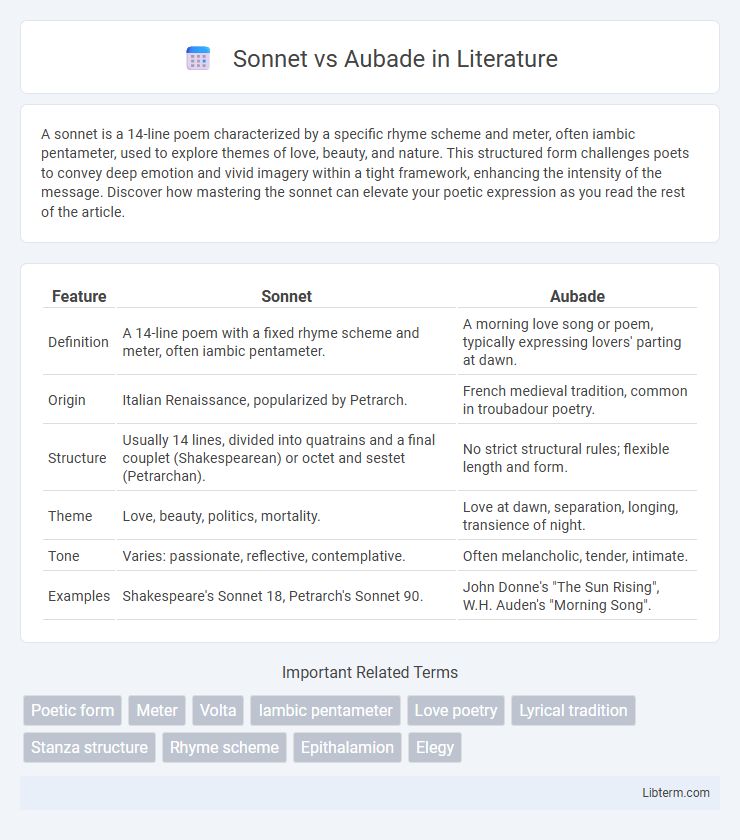A sonnet is a 14-line poem characterized by a specific rhyme scheme and meter, often iambic pentameter, used to explore themes of love, beauty, and nature. This structured form challenges poets to convey deep emotion and vivid imagery within a tight framework, enhancing the intensity of the message. Discover how mastering the sonnet can elevate your poetic expression as you read the rest of the article.
Table of Comparison
| Feature | Sonnet | Aubade |
|---|---|---|
| Definition | A 14-line poem with a fixed rhyme scheme and meter, often iambic pentameter. | A morning love song or poem, typically expressing lovers' parting at dawn. |
| Origin | Italian Renaissance, popularized by Petrarch. | French medieval tradition, common in troubadour poetry. |
| Structure | Usually 14 lines, divided into quatrains and a final couplet (Shakespearean) or octet and sestet (Petrarchan). | No strict structural rules; flexible length and form. |
| Theme | Love, beauty, politics, mortality. | Love at dawn, separation, longing, transience of night. |
| Tone | Varies: passionate, reflective, contemplative. | Often melancholic, tender, intimate. |
| Examples | Shakespeare's Sonnet 18, Petrarch's Sonnet 90. | John Donne's "The Sun Rising", W.H. Auden's "Morning Song". |
Introduction to Poetic Forms
The sonnet, a 14-line poem with a strict rhyme scheme and meter, traditionally explores themes of love, nature, and philosophy, often structured in quatrains and a couplet. The aubade, a morning love poem set at dawn, captures the bittersweet emotions of lovers parting at daybreak, typically maintaining a lyrical and intimate tone. Both forms showcase distinct approaches to rhythmic and thematic expression in poetry, emphasizing structured creativity.
Defining the Sonnet
The sonnet is a 14-line poetic form traditionally written in iambic pentameter, structured into specific rhyme schemes such as the Shakespearean (ABABCDCDEFEFGG) or Petrarchan (ABBAABBACDCDCD) patterns. It typically explores themes of love, mortality, or nature, delivering a concise and structured argument or emotional reflection within its tight framework. In contrast to the aubade, which is a morning love poem or a song about lovers parting at dawn, the sonnet emphasizes formal precision and thematic depth through its established literary conventions.
Understanding the Aubade
The aubade is a poetic form that traditionally captures the emotions and themes surrounding the dawn, often exploring separation or longing at daybreak, distinguishing it from the sonnet's structured, often romantic or contemplative themes. Unlike the sonnet, which typically consists of 14 lines with a fixed rhyme scheme, the aubade varies in structure but centers on the early morning light as a symbolic backdrop. Understanding the aubade involves recognizing its focus on transitions from night to day and the emotional resonance this time of day evokes in poetry.
Historical Origins and Evolution
The sonnet originated in 13th-century Italy, popularized by Petrarch, and evolved through Renaissance poets like Shakespeare, becoming a 14-line poem with a structured rhyme scheme exploring themes of love and mortality. The aubade has roots in medieval French lyric poetry, traditionally serving as a morning love song or farewell at dawn, characterized by themes of parting and the transition from night to day. Both forms have adapted over centuries, with the sonnet evolving into various structural variants and the aubade expanding its thematic scope beyond romantic farewells.
Structural Differences
Sonnets traditionally consist of 14 lines with a specific rhyme scheme, often following the Shakespearean or Petrarchan form, while aubades are typically shorter lyric poems focusing on the dawn or morning. The sonnet's structured quatrains and concluding couplet emphasize formal rhythmic patterns and thematic development, whereas the aubade's form is more flexible, prioritizing the evocation of early morning imagery. This structural distinction highlights the sonnet's intricate rhyme complexity versus the aubade's open, lyrical expression.
Common Themes and Motifs
Sonnets and aubades both explore themes of love, but sonnets often delve into passion, beauty, and the complexities of desire, while aubades traditionally focus on the parting of lovers at dawn, capturing the bittersweet emotions of separation. Motifs such as time, nature, and the tension between night and day appear frequently in both forms, symbolizing love's transient and eternal qualities. The interplay of light and darkness serves as a powerful metaphor across sonnets and aubades, reflecting emotional contrasts like longing and fulfillment.
Language and Tone Comparison
Sonnets employ structured iambic pentameter and rhyme schemes, using formal, often elevated language to explore themes of love, nature, or existence with contemplative, passionate tones. Aubades feature freer verse and imagery centered on dawn and parting lovers, with intimate, tender language that conveys a bittersweet, melancholic tone. The sonnet's language tends to be metaphor-rich and abstract, while the aubade's diction emphasizes sensory details and emotional immediacy.
Notable Examples in Literature
Shakespeare's Sonnet 18 ("Shall I compare thee to a summer's day?") remains a pinnacle example of the sonnet form, emphasizing themes of love and beauty. In contrast, John Donne's "The Good-Morrow" exemplifies an aubade, a dawn love song that explores awakening and intimacy at daybreak. These works highlight the distinctive emotional tones and structural elements defining sonnets and aubades in classical English literature.
Influence on Modern Poetry
Sonnet and Aubade both exert significant influence on modern poetry through their distinct structural and thematic conventions. The sonnet's 14-line format and thematic focus on love and existential reflection have shaped contemporary poetic forms and emotional expression. Aubade's dawn-themed exploration of parting lovers inspires modern poets to blend natural imagery with intimate emotions, enriching lyrical diversity.
Choosing Between Sonnet and Aubade
Choosing between a sonnet and an aubade depends on the thematic focus and emotional tone of the poem. Sonnets typically explore themes of love, nature, and philosophical reflections within a strict 14-line, iambic pentameter format, allowing for intricate rhyme schemes such as the Shakespearean or Petrarchan structure. Aubades, on the other hand, specialize in portraying the early morning and the bittersweet parting of lovers at dawn, often emphasizing themes of separation, yearning, and the transient beauty of daybreak.
Sonnet Infographic

 libterm.com
libterm.com